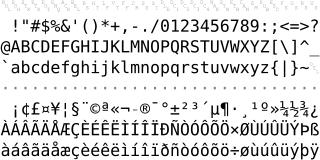Related Research Articles

ISO/IEC 8859-1:1998, Information technology — 8-bit single-byte coded graphic character sets — Part 1: Latin alphabet No. 1, is part of the ISO/IEC 8859 series of ASCII-based standard character encodings, first edition published in 1987. ISO/IEC 8859-1 encodes what it refers to as "Latin alphabet no. 1", consisting of 191 characters from the Latin script. This character-encoding scheme is used throughout the Americas, Western Europe, Oceania, and much of Africa. It is the basis for some popular 8-bit character sets and the first two blocks of characters in Unicode.

Unicode, formally The Unicode Standard, is a text encoding standard maintained by the Unicode Consortium designed to support the use of text written in all of the world's major writing systems. Version 15.1 of the standard defines 149813 characters and 161 scripts used in various ordinary, literary, academic, and technical contexts.
ISO/IEC 8859-4:1998, Information technology — 8-bit single-byte coded graphic character sets — Part 4: Latin alphabet No. 4, is part of the ISO/IEC 8859 series of ASCII-based standard character encodings, first edition published in 1988. It is informally referred to as Latin-4 or North European. It was designed to cover Estonian, Latvian, Lithuanian, Greenlandic, and Sámi. It has been largely superseded by ISO/IEC 8859-10 and Unicode. Microsoft has assigned code page 28594 a.k.a. Windows-28594 to ISO-8859-4 in Windows. IBM has assigned code page 914 to ISO 8859-4.
ISO/IEC 8859-5:1999, Information technology — 8-bit single-byte coded graphic character sets — Part 5: Latin/Cyrillic alphabet, is part of the ISO/IEC 8859 series of ASCII-based standard character encodings, first edition published in 1988. It is informally referred to as Latin/Cyrillic.
ISO/IEC 8859-14:1998, Information technology — 8-bit single-byte coded graphic character sets — Part 14: Latin alphabet No. 8 (Celtic), is part of the ISO/IEC 8859 series of ASCII-based standard character encodings, first edition published in 1998. It is informally referred to as Latin-8 or Celtic. It was designed to cover the Celtic languages, such as Irish, Manx, Scottish Gaelic, Welsh, Cornish, and Breton.
ISO/IEC 8859-16:2001, Information technology — 8-bit single-byte coded graphic character sets — Part 16: Latin alphabet No. 10, is part of the ISO/IEC 8859 series of ASCII-based standard character encodings, first edition published in 2001. The same encoding was defined as Romanian Standard SR 14111 in 1998, named the "Romanian Character Set for Information Interchange". It is informally referred to as Latin-10 or South-Eastern European. It was designed to cover Albanian, Croatian, Hungarian, Polish, Romanian, Serbian and Slovenian, but also French, German, Italian and Irish Gaelic.

ArmSCII or ARMSCII is a set of obsolete single-byte character encodings for the Armenian alphabet defined by Armenian national standard 166–9. ArmSCII is an acronym for Armenian Standard Code for Information Interchange, similar to ASCII for the American standard. It has been superseded by the Unicode standard.

Code page 850 is a code page used under DOS operating systems in Western Europe. Depending on the country setting and system configuration, code page 850 is the primary code page and default OEM code page in many countries, including various English-speaking locales, whilst other English-speaking locales default to the hardware code page 437.

Code page 437 is the character set of the original IBM PC. It is also known as CP437, OEM-US, OEM 437, PC-8, or DOS Latin US. The set includes all printable ASCII characters as well as some accented letters (diacritics), Greek letters, icons, and line-drawing symbols. It is sometimes referred to as the "OEM font" or "high ASCII", or as "extended ASCII".
The Kamenický encoding, named for the brothers Jiří and Marian Kamenický, was a code page for personal computers running DOS, very popular in Czechoslovakia around 1985–1995. Another name for this encoding is KEYBCS2, the name of the terminate-and-stay-resident utility which implemented the matching keyboard driver. It was also named KAMENICKY.
Several 8-bit character sets (encodings) were designed for binary representation of common Western European languages, which use the Latin alphabet, a few additional letters and ones with precomposed diacritics, some punctuation, and various symbols. These character sets also happen to support many other languages such as Malay, Swahili, and Classical Latin.
Symbol is one of the four standard fonts available on all PostScript-based printers, starting with Apple's original LaserWriter (1985). It contains a complete unaccented Greek alphabet and a selection of commonly used mathematical symbols. Insofar as it fits into any standard classification, it is a serif font designed in the style of Times New Roman.
ISO 6438:1983, Documentation — African coded character set for bibliographic information interchange, is an ISO standard for an 8-bit character encoding for African languages. Developed separately from the African reference alphabet but apparently based on the same data sets, it has had little use; its forms are retained Unicode. FreeDOS calls this Code Page 65504.
Mac OS Icelandic is an obsolete character encoding that was used in Apple Macintosh computers to represent Icelandic text. It is largely identical to Mac OS Roman, except for the Icelandic special characters Ý, Þ and Ð which have replaced typography characters.

The ZX Spectrum character set is the variant of ASCII used in the ZX Spectrum family computers. It is based on ASCII-1967 but the characters ^, ` and DEL are replaced with ↑, £ and ©. It also differs in its use of the C0 control codes other than the common BS and CR, and it makes use of the 128 high-bit characters beyond the ASCII range. The ZX Spectrum's main set of printable characters and system font are also used by the Jupiter Ace computer.
The GEM character set is the character set of Digital Research's graphical user interface GEM on Intel platforms. It is based on code page 437, the original character set of the IBM PC.
Mac OS Gaelic is a character encoding created for the Irish Gaelic language, based on the Welsh Mac OS Celtic encoding but replacing 23 characters with Gaelic characters. It was developed by Michael Everson, and was in his CeltScript fonts and on some fonts included with the Irish localization of Mac OS 6.0.8 and 7.1 and on. FreeDOS calls it code page 58619.
Mac OS Sámi is a character encoding used on classic Mac OS to represent the Sámi languages and the Finnish Kalo language. While not used in any official Apple product, it has been used in various fonts designed to support Sámi languages under classic Mac OS, including those from Evertype. FreeDOS calls it code page 58630.
CER-GS is a character encoding for Windows CeltScript fonts. It is deprecated by Extended Latin-8, which contains the euro and disunifies the ampersands.
ISO-IR-197 is an 8-bit, single-byte character encoding which was designed for the Sámi languages. It is a modification of ISO 8859-1, replacing certain punctuation and symbol characters with additional letters used in certain Sámi orthographies. FreeDOS calls it code page 59187.
References
- ↑ "Latin 8 Extended" . Retrieved 27 February 2017.
- ↑ "CER-GS" . Retrieved 27 February 2017.
- ↑ "Cpi/CPIWIN/Codepage.TXT at master · FDOS/Cpi". GitHub .